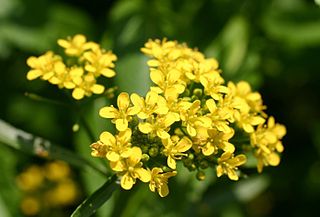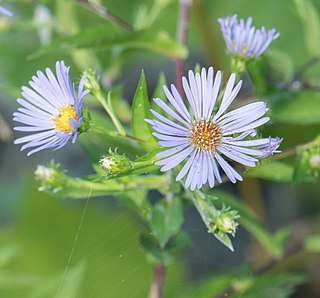
Watercress or yellowcress is a species of aquatic flowering plant in the cabbage family Brassicaceae.

Sceptridium is a genus of seedless vascular plants in the family Ophioglossaceae, closely allied to the genus Botrychium. It is also closely related to the genus Botrypus. Sceptridium species are commonly called the grape-ferns.

Nasturtium is a genus of a small number of plant species in the family Brassicaceae commonly known as watercress or yellowcress. The best known species are the edible Nasturtium officinale and Nasturtium microphyllum. Nasturtium was previously synonymised with Rorippa, but molecular evidence supports its maintenance as a distinct genus more closely related to Cardamine than to Rorippasensu stricto.

Rorippa is a genus of flowering plants in the family Brassicaceae, native to Europe through central Asia, Africa, and North America. Rorippa species are annual to perennial herbs, usually with yellow flowers and a peppery flavour. They are known commonly as yellowcresses.

Vaccinium uliginosum is a Eurasian and North American flowering plant in the genus Vaccinium within the heath family.

Tropaeolum majus, the garden nasturtium, nasturtium, Indian cress or monk's cress, is a species of flowering plant in the family Tropaeolaceae, originating in the Andes from Bolivia north to Colombia. An easily-grown annual or short-lived perennial with disc-shaped leaves and brilliant yellow, orange or red flowers, it is of cultivated, probably hybrid origin. It is not closely related to the genus Nasturtium.

Solidago canadensis, known as Canada goldenrod or Canadian goldenrod, is an herbaceous perennial plant of the family Asteraceae. It is native to northeastern and north-central North America and often forms colonies of upright growing plants, with many small yellow flowers in a branching inflorescence held above the foliage. It is an invasive plant in other parts of the continent and several areas worldwide, including Europe and Asia. It is grown as an ornamental in flower gardens.

Symphyotrichum puniceum, is a species of flowering plant in the family Asteraceae native to eastern North America. It is commonly known as purplestem aster, red-stalk aster, red-stemmed aster, red-stem aster, and swamp aster. It also has been called early purple aster, cocash, swanweed, and meadow scabish.

Allium cernuum, known as nodding onion or lady's leek, is a perennial plant in the genus Allium. It grows in open areas in North America.

Ligustrum obtusifolium is a species of privet, native to Japan, Korea and northeastern China. The species is considered invasive in parts of the United States. It has become very common in southern New England, the mid-Atlantic States, and the Great Lakes regions, with scattered occurrences in the South, the Great Plains, and Washington state. With Ligustrum ovalifolium it is a parent of the widespread hybrid Ligustrum × ibolium.

Symphyotrichum laeve is a flowering plant native to Canada, the United States, and Coahuila (Mexico). It has the common names of smooth blue aster, smooth aster, smooth-leaved aster, glaucous Michaelmas-daisy and glaucous aster.

Allium acuminatum, also known as the tapertip onion or Hooker's onion, is a species in the genus Allium native to North America.

Lygodium microphyllum is a climbing fern originating in tropical Africa, Southeast Asia, Melanesia and Australia. It is an invasive weed in Florida where it invades open forest and wetland areas. The type specimen was collected in the vicinity of Nabúa, on the island of Luzon in the Philippines by Luis Née.

Spinulum annotinum, synonym Lycopodium annotinum, known as interrupted club-moss, or stiff clubmoss, is a species of clubmoss native to forests of the colder parts of North America, as well as Asia, and most of Europe. The genus Spinulum is accepted in the Pteridophyte Phylogeny Group classification of 2016, but not in other classifications, which submerge the genus in Lycopodium.
Trichophorum clintonii, the Clinton's bulrush, is a plant species native to Canada and the northeastern United States. It has been reported from Alberta, Saskatchewan, Ontario, Québec, New Brunswick, Maine, New York State, Michigan, Wisconsin, and Minnesota.
Nasturtium floridanum, common names Florida yellowcress and Florida watercress, is an aquatic plant species endemic to Florida, though widely distributed within that state. It is found in wet places at elevations less than 50 m.

Solidago rigida, known by the common names stiff goldenrod and stiff-leaved goldenrod, is a North American plant species in the family Asteraceae. It has a widespread distribution in Canada and the United States, where it is found primarily east of the Rocky Mountains. It is typically found in open, dry areas associated with calcareous or sandy soil. Habitats include prairies, savannas, and glades.

Solidago latissimifolia, common name Elliott's goldenrod, is North American species of flowering plants in the family Asteraceae. It is native to the Atlantic Coast of the United States and Canada, from Nova Scotia south to Alabama and Florida.

Solidago uliginosa, or bog goldenrod, is a North American species of flowering plants in the family Asteraceae. It is found in eastern Canada and the eastern United States.

















